What size mountain bike frame do I need? That’s one of the most commonly asked questions by our readers.
Ordering bikes online is becoming more and more popular. Bikes are typically more affordable online than in local bike shops because overhead costs are lower, allowing online stores to sell their bikes at cheaper prices.
But what about the good old rule that says you need to try a bike before buying it? While this can be beneficial, it’s often an overrated method and not necessary for everyone.
If you go to a local bike shop and sit on a bike, you’re more likely to buy it, which is why shopkeepers would like you to do it. But the reality is that most novice riders don’t know how a bike should feel during their first test ride, so this sizing method is not valuable for inexperienced riders.
You should try your bike first! Not completely true!
Even though everyone is built differently, most people’s bodies fall into certain categories in terms of height, inseam length, and arm length. Therefore, unless you’re have an unusual ratio of upper and lower body length, you can trust mountain bike size charts to recommend you the right frame size.
Related: Best Mountain Bikes You Can Get
With that in mind, there are several reliable methods to choose the right mountain bike frame size.
In this article, I’m going to show you how to use mountain bike size charts and online calculators to get the right size and fit in seconds!
Contents
Method #1: Mountain Bike Size Chart
The easiest way to find the correct bike size is by using a mountain bike frame size chart. This is a simple method that lets you compare your height and/or inseam length against a chart that recommends the correct frame size.
Mountain bike frame sizes are measured based on seat tube length, expressed in inches, which typically ranges from 13″ to 24″. Effective top tube length (the horizontal distance between the head tube and the seat tube) plays a role as well, but seat tube length is a more common measurement.
Some manufacturers also use size classes, such as XS, S, M, L, and XL, but these are not as reliable as using inches because the measurements can differ from one brand to another.
What mountain bike frame size do I need? Find the answer in the chart below:
| Rider Height | Suggested Mountain Frame Size | ||
| Feet & Inches | Centimeters | Frame Size (inches) | Size Classes |
| 4’10” – 5’2″ | 148cm – 158cm | 13″ – 14″ | X-Small |
| 5’2″ – 5’6″ | 158cm – 168cm | 15″ – 16″ | Small |
| 5’6″ – 5′ 10″ | 168cm – 178cm | 17″ – 18″ | Medium |
| 5’10” – 6’1″ | 178cm – 185cm | 19″ – 20″ | Large |
| 6’1″ – 6’4″ | 185cm – 193cm | 21″ – 22″ | X-Large |
| 6’4″ – 6’6″ | 193cm – 198cm | 23″ – 24″ | XX-Large |
Bonus tip: If you’re buying a bike on Amazon, you can also check out their Amazon Fit Guide which includes sizing recommendations for adult road bikes, adult mountain bikes, and kids’ bikes.
Related: Best Gravel Bikes You Can Buy
Method #2: Online Bike Size Calculator
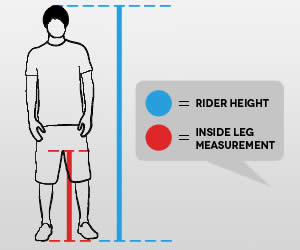 The next best way to find the right mountain bike size based on your height and inseam length is to use an online bike size calculator.
The next best way to find the right mountain bike size based on your height and inseam length is to use an online bike size calculator.
These are interactive tools that let you enter your height and inseam length and then recommend you the correct size or range of sizes to consider.
Before you can use one, you need to learn how to correctly measure your inseam. Here’s a quick step-by-step guide:
- Take off your shoes and stand with your legs 6″ to 8″ (15-20 cm) apart.
- Place a book between your legs, as far up as you can.
- Measure the length from the ground up to the top of the book.
- Voila! This is your inseam length that you can now enter into an online bike size calculator.
When using a bike size calculator, make sure to choose the right type of bike—mountain bike, city bike, or road bike—as the measurements will differ based on that.
If you’re not sure about it, you can read more about the different bike types here.
Here are the top online bike frame size calculators we recommend:
1. Ebicycles.com Online Calculator: An easy way to find the right MTB frame size by using your height and inseam length.
2. Competitive Cyclist Fit Calculator: A more detailed bike fit calculator that lets you know the correct standover height range, top tube length, saddle height, and more.
3. Jenson USA Bike Fit Calculator: Another in-depth bike fit calculator that suggests the right bike size and helps you nail the fit afterward.
Method #3: Mountain Bike Sizing Formula
One of the easiest but also the least reliable methods of finding the right mountain bike size is using a simple mathematical formula that uses your inseam length.
It goes like this:
Leg inseam (cm) x 0.66 = Your frame size
For example, if your leg inseam is 76cm, multiplied by 0.66 then your correct mountain bike size is 20″ (50cm).
This method is only good for approximating the correct size, but we don’t recommend relying on it exclusively. It’s best to combine it with the results you get from the mountain bike size chart and online calculator that we’ve shown you above.
Bonus Tip: Finding the Right Saddle Height
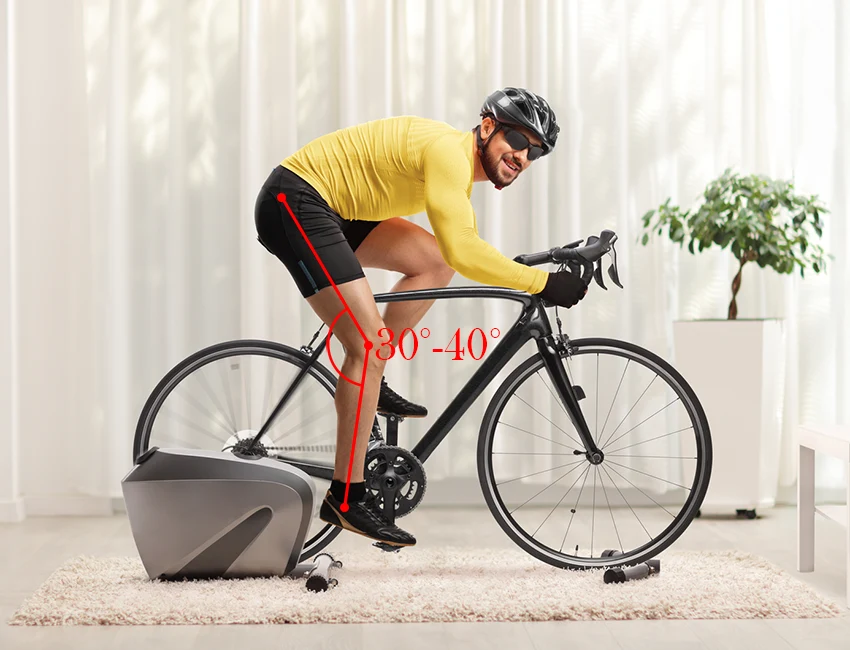
Setting the saddle height correctly has a very important impact on the overall bike fit.
If the saddle height is too low, you won’t be able to transfer power to the pedals effectively and your legs may fatigue more quickly. I have experienced that firsthand in mountain bike racing—when the saddle falls down by one inch from its ideal position, I lose about 25-50% of my power.
Now that we know how important finding the perfect saddle height is, how should we do it?
The easiest way is to:
- Hop on your bike wearing the shoes that you typically use for cycling (flat or clipless).
- Lean against the wall for support or have someone help you stay in an upright position. You can also use a bike trainer for this purpose.
- Push the pedal down to its lowest point (6 o’clock) while keeping the foot parallel to the ground.
- At this point, you should have a slight bend in the knee, as shown in the image above. Adjust the saddle height accordingly until you achieve it.
The next step is to go outside and ride. Does it feel good? If not, then make further minimal adjustments (a few millimeters at a time) until the saddle height feels natural, your power transfer is optimal, and you’re not feeling any pains or aches.
Related: Check Out The Best Fat Tire Bikes
 Bicycle Guider’s TIP:
Bicycle Guider’s TIP:
Once you’ve determined your ideal saddle height, it’s a good idea to mark that position with a marker, as saddles can lower with time. Some bikes come with height indicators on the seat post, so make sure to remember the correct marking for future reference.
MTB Geometry Guide
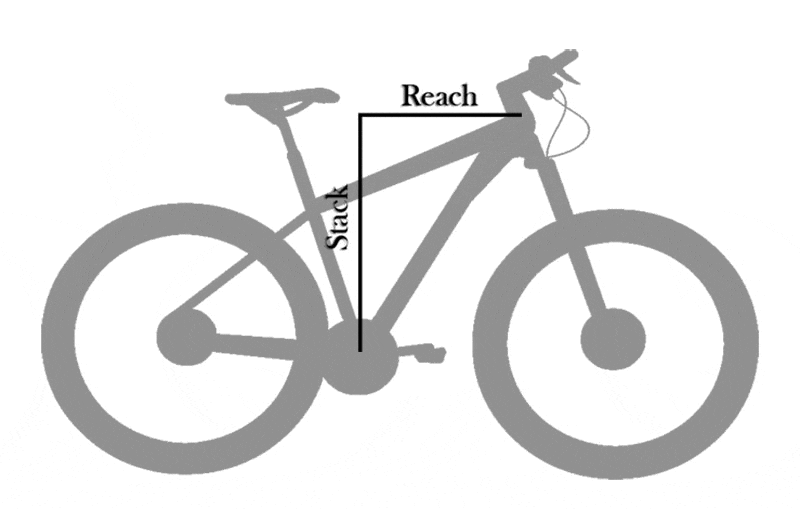
Mountain bike geometry refers to the actual shape of the bicycle, the measurements of different tubes and angles, and their relations to each other.
Here’s a brief guide on the most important measurements you need to be aware of to get the right fit:
- Reach: This measurement refers to the horizontal distance between the center of the bottom bracket to the top center of the head tube. It affects the length of the bike and the overall stability and ride feel.
- Stack: Refers to the vertical distance between the center of the bottom bracket to the top center of the head tube. It affects how upright your position will be and how tall the handlebar will be.
- Standover height: This is the height from the ground to the top of the top tube. Make sure that this measurement is at least an inch shorter than your inseam length to be able to stand over the bike with both feet flat on the ground.
- Wheelbase: This is the distance between the centers of both wheels. A shorter wheelbase provides more agility, while a longer wheelbase improves stability.
- Head tube angle: This is the angle between the ground and the bike’s fork. A slacker angle (lower number) means the bike is more stable on rough terrain, while a steeper angle allows more responsive steering.
- Seat tube angle: This measurement refers to the angle between the ground and the seat tube. A steeper angle improves climbing ability, whereas a slacker angle is better for descending.
How to Choose When In-Between Two Sizes?
So you’ve consulted a mountain bike size chart or an online calculator and the results put you right in the middle of two sizes. What do you do? Should you size up or size down?
Each option has some pros and cons and the final decision depends on your:
- Flexibility
- Leg-to-torso length ratio
- Riding style
Here are some of the most important factors to consider when deciding whether to get a one size bigger or smaller mountain bike.
When to Size Up?
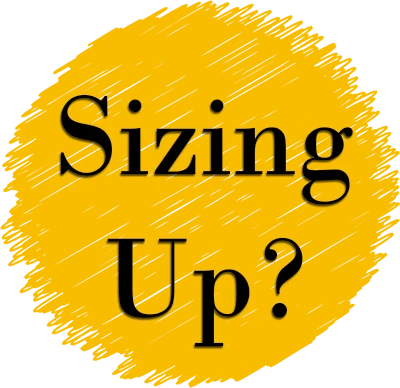
Mountain bikes grow in length (reach) and in height (stack) with each frame size. But modern mountain bikes grow more in length (reach), which is why this is a more important measurement to consider.
Assume you are in between two sizes and you decide to size up. You’ll get a bike with a longer top tube and a longer wheelbase, which means your handlebar will be further away from the saddle.
How does this affect the factors we’ve mentioned above?
Flexibility: This is a good option for riders who are flexible and can easily reach their toes when bent over. A longer top tube means you will need to hinge more at the hips, which can be painful and uncomfortable if you’re stiff and have a short range of motion.
Leg-to-torso length ratio: If you have short legs and a long torso, you should size up when buying a mountain bike as this will give you a more neutral fit. But make sure that the standover height is not too high so that you can’t stand over the bike comfortably.
Riding style: Finally, a larger frame size translates to a longer wheelbase, which means the bike will be more stable on rough terrain and go over obstacles with more ease, but it will feel less playful and more difficult to maneuver.
When to Size Down?
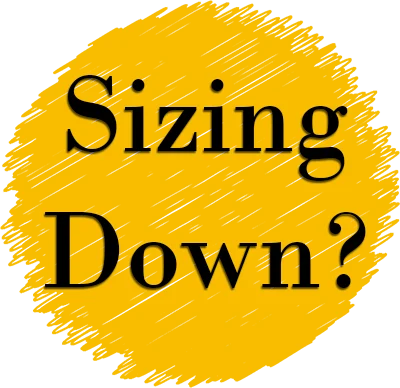
Similarly, a smaller mountain bike will have a significantly shorter reach and a slightly shorter stack and wheelbase. A smaller bike will also have a shorter maximum seat post height, so you may need to extend it depending on how long your legs are.
So how does this relate to the three most important factors mentioned above?
Flexibility: If you are not a flexible person and you struggle to reach your toes with your fingers, then you’ll benefit from a shorter reach a smaller mountain bike frame size offers. It will put you in a more upright riding position, with handlebars closer to your body, which means you can ride for longer without experiencing discomfort.
Leg-to-torso length ratio: Sizing down is a logical choice for riders who have longer legs and shorter torsos. This way, the bike will feel more comfortable, but you may need to use a longer seat post to get the proper leg extension.
Riding style: A smaller mountain bike with a shorter wheelbase will feel more nimble, playful, and easier to handle over rough terrain. If you like flicking your rear wheel and going around obstacles instead of plowing through them, a smaller bike is the right choice.
What If I Still Got the Wrong Bike Size?
Sometimes, even after going through all the methods and consulting several mountain bike size charts, you may find that the bike doesn’t feel right and that you’ve probably chosen the wrong bike size.
Don’t worry, if you’re off by one size or even half a size, there are easy fixes you can try to improve the comfort and fit!
The first thing to do is to contact the retailer/manufacturer and try to get a replacement. Under the right conditions, you’ll be able to get a different frame size bike without significant additional costs.
If you don’t want to go through the hassle of shipping the bike or this option is not available, you can try the following things:
- Adjust the fore-aft position of the saddle: The fore-aft position of the saddle can be adjusted slightly to lengthen or shorten the reach. Make sure not to overdo it so your knee doesn’t end up too far in front or behind the middle of your foot when in the 3 o’clock position.
- Replace the stem: By using a longer or a shorter stem, you’ll be able to increase or shorten the reach by a few centimeters. In most cases, this will be enough to significantly improve the feel and ride quality.
- Replace the seat post: If you bought a bike that is too small and you can’t extend the leg fully when pedaling, consider using a longer seat post.
- Replace the handlebar: A shorter handlebar will be easier to reach and will put you in a less stretched-out position and vice-versa. If you’re using drop bars, consider getting a model with a shorter or longer reach to fine-tune your fitment.
- Raise the handlebar: You can easily achieve a more upright riding position and increase the stack measurement by raising the handlebar with headset spacers. If there are headset spacers above your stem, simply move them underneath to move the stem and handlebar higher up.
- Get a professional bike fitting: A professional bike fitter can do all of these steps for you, which is the best option you have, but also the costliest.
Most importantly, give yourself time to get accustomed to your new bike. Sometimes, your body needs a few days or weeks to adjust to the new riding position.
I remember when I got my first 29er mountain bike. It felt huge and I found it difficult to ride it on narrow winding trails and on technical terrain. However, now that I’m used to the 29er, the 26″ mountain bike seems almost comically small.
Mountain Bike Reviews
Are you in the market for a new mountain bike? Start with one of our mountain bike buying guides below:


Hi
I’m 5’11 with 32″ legs and slighter shorter wing span to height. Am looking at getting the giant xtc slr 29. Do you recommend M or L?
Thanks.
Hi Ian, considering all your measurements, I think you won’t go wrong if you choose the smaller M frame size.
You should also consider your riding style, as the size of the frame will affect how the bike feels. For example, if you prefer a more nimble, responsive ride and you value quick handling for tight trails, go with Medium. However, if you want a more comfortable, stretched-out position and you prioritize stability at higher speeds, you should go with Large.
But if you’re simply worried about getting a comfortable fit, I say you should choose Medium.
Cheers!
Hi. I am 6ft 1 90kg. Should I go for XL or L?
Hey TJ, I think a 19″-20″ (L) mountain bike would be the right choice for you.
I am wanting a bike with the 29” wheel. I am that 5’11 to 6’1 I want to spend 1000 for a hard tail. My inseam is short like 31” I do like the Cannandal the black one. I just want a good rider. Do I want the 27” wheel? I think the large frame not sure at all
Hey Richard, at that height, both a 29er and a 27.5er will fit you fine. Size Large Cannondale should be the right choice for you considering your 5’11” to 6’1″ height.
Hello, I am 165cm in height.. so can i ride on a 17-inch frame bike? Is it suitable for my height?
Hey Am, you should be better off with a 15″-16″ bike, but depending on the model, a 17″ bike could fit you as well. It’s best to give it a try if you can.
I’m 5.7 – right in the middle of a MED and a SM… so hard to decide what size I should go with.. is it really much of a difference? I’m looking into a Fusion 30 2022… I ride both pathways/roads to basic mountain trails… Is the only difference the more responsiveness in a small rather a med?
Hey Christa, it’s usually better to go for the smaller size when you’re right in the middle. It’s a lot easier to lengthen a smaller size bike than shorten a larger size. So I would say go for a SM and enjoy it.
Great article!! It definitely clears out some of my struggle. But still, I have this main concern that is the right range of reach and stack for my height. I am 5″11, 180 cm. I have longer limbs than most people, but super lean, about 68 kg 150 lbs. I am currently riding a L hardtail with 470 reach and 620 stack, I always feel it is too big for me, but every single size chart suggest that the L is perfect size for me. I ended up used mullet wheelset and use the shortest stem that fit- 32mm. Now it feels about right. I am going to purchase my first full sus bike next year, and the 29er enduro bike I am looking at has M(450 reach and 442 chainstay and 630 stack) while L(475 reach, 435 chainstay and 640 stack). I know that the 475 is definately too big for me, but the 450 seem too short too. My most riding condition is XC trails 50%(lot of climb but not too techy), dirt jump park15%, urban freeride 15%(mainly just up and down stairs and bunny hop some curbs) and downhill park 20%. I like doing bunny hops, manual and wheelie, pop some small bump here and there, not a speed seeker but I will use this bike on Whistler bike park so it can’t just be a big full-sus BMX. Since neither size is spot on, and based on my goal, do you think I should go M with a longer stem 50mm+, or gain 15 lbs muscle and get the Large.
Looking forward to hearing your thoughts,
Thanks
Sorry, Correction :Chainstay length is M 435mm, L 442mm. The specific bike I am looking at is the Cannodale jekyll. It is an DH oriented enduro, but I am not going to use it for dh only, so this is another reason why it is tempting to size down.
Hi Karl,
That is why we always emphasize here the need for a proper bike fit. Sure, the standard size should fit people under that category, but making adjustments with the length of the stem, saddle fore and aft, and sometimes crank length is crucial for general comfort during long rides. And talking about sizing down, the smaller the frame, the more responsive the bike is, but here we still rely on what’s conventional, especially since we cater to the general cycling public and not pro racers. So, in conclusion, you need to follow what you feel is comfortable to you.
I am 6’3 (75 in), inseam is 93 cm. What size mountain bike would you recommend? I’ve been told that my inseam is longer than average person of my height.
Hi Craig,
I suggest you get the XL just to be on the safe side and do minor tweaks after, for your comfort. Getting a proper bike fit is the safest bet especially when you suspect that your body geometry is unique.
My mistake, my inside leg to floor measurement is 34in